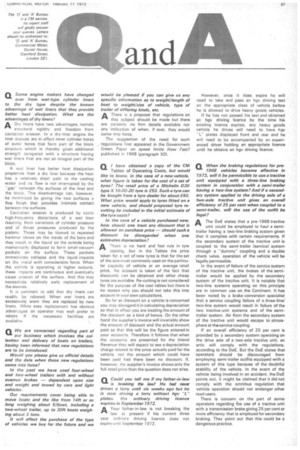Q When the braking regulations for pre
Page 59

If you've noticed an error in this article please click here to report it so we can fix it.
1968 vehicles become effective in 1973, will it be permissible to use a tractive unit equipped with a three-line braking system in conjunction with a semi-trailer having a two-line system? And if a secondary system applied to the driving axle of a two-axle tractive unit gives an overall efficiency of 25 per cent when coupled to a semi-trailer, will the use of the outfit be legal?
A The DoE states that a pre-1968 tractive unit could be employed to haul a semitrailer having a two-line braking system given that it complies with certain requirements. if the secondary system of the tractive unit is coupled to the semi-trailer (service) system through a "dummy" coupling and a double check valve, operation of the vehicle will be 'legally permissible.
In the event of failure of the service system of the tractive unit, the brakes of the semitrailer would he applied by the secondary system of the tractive unit. It is notable that two-line systems operating on this principle are in common use on the Continent. It has been noted by a brake-conversion specialist that a service coupling failure of a three-line/ two-line system would result in failure of the two tractive-unit systems and of the semitrailer system. Air from the secondary system of the tractive unit would escape to atmosphere at theservice coupling.
If an overall efficiency of 25 per cent is provided by a secondary system operating on the drive axle of a two-axle tractive unit, an artic will comply with the regulations, according to the DoE. But the DoE states that operators should be discouraged from employing semi-trailer outfits equipped with a system of this type because of the doubtful stability of the vehicle. In the event of the vehicle being involved in an accident, the DoE points out, it might be claimed that it did not comply with the omnibus regulation that vehicle operation should not endanger other road users.
There is concern on the part of some operators regarding the use of a tractive unit with a transmission brake giving 25 per cent or more efficiency that is employed for secondary braking. They point out that this could be a dangerous practice.








































































































